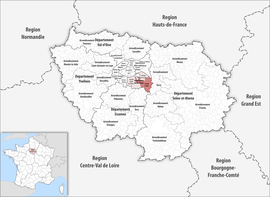Arrondissement of Créteil
The arrondissement of Créteil is an arrondissement of France in the Val-de-Marne department in the Île-de-France region. It has 16 communes.[1] Its population is 310,758 (2016), and its area is 99.8 km2 (38.5 sq mi).[2]
Créteil | |
|---|---|
 Location within the region Île-de-France | |
| Country | France |
| Region | Île-de-France |
| Department | Val-de-Marne |
| No. of communes | 16 |
| Prefecture | Créteil |
| Area | |
| • Total | 99.8 km2 (38.5 sq mi) |
| Population (2016) | |
| • Total | 310,758 |
| • Density | 3,114/km2 (8,070/sq mi) |
| INSEE code | 941 |
Composition
The communes of the arrondissement of Créteil, and their INSEE codes, are:[1]
- Alfortville (94002)
- Boissy-Saint-Léger (94004)
- Bonneuil-sur-Marne (94011)
- Chennevières-sur-Marne (94019)
- Créteil (94028)
- Limeil-Brévannes (94044)
- Mandres-les-Roses (94047)
- Marolles-en-Brie (94048)
- Périgny (94056)
- Le Plessis-Trévise (94059)
- La Queue-en-Brie (94060)
- Saint-Maur-des-Fossés (94068)
- Saint-Maurice (94069)
- Santeny (94070)
- Sucy-en-Brie (94071)
- Villecresnes (94075)
History
The arrondissement of Créteil was created in 1964 as part of the department Seine.[3] In 1968 it became part of the new department Val-de-Marne.[4] On 25 February 2017, it lost 8 communes to the arrondissement of L'Haÿ-les-Roses, and it lost 2 communes to and gained 3 communes from the arrondissement of Nogent-sur-Marne.[5]
As a result of the reorganisation of the cantons of France which came into effect in 2015, the borders of the cantons are no longer related to the borders of the arrondissements. The cantons of the arrondissement of Créteil were, as of January 2015:[6]
- Alfortville-Nord
- Alfortville-Sud
- Boissy-Saint-Léger
- Bonneuil-sur-Marne
- Charenton-le-Pont
- Choisy-le-Roi
- Créteil-Nord
- Créteil-Ouest
- Créteil-Sud
- Ivry-sur-Seine-Est
- Ivry-sur-Seine-Ouest
- Maisons-Alfort-Nord
- Maisons-Alfort-Sud
- Orly
- Saint-Maur-des-Fossés-Centre
- Saint-Maur-des-Fossés-Ouest
- Saint-Maur-La Varenne
- Sucy-en-Brie
- Valenton
- Villecresnes
- Villeneuve-le-Roi
- Villeneuve-Saint-Georges
- Vitry-sur-Seine-Est
- Vitry-sur-Seine-Nord
- Vitry-sur-Seine-Ouest
References
- "Arrondissement de Créteil (941)". INSEE. Retrieved 2019-10-05.
- "Comparateur de territoire, géographie au 01/01/2019". INSEE. Retrieved 2019-10-04.
- Ancien département : la Seine
- Historique du Val-de-Marne
- "Arrêté préfectoral, 24 February 2017" (PDF). pp. 19–21. Retrieved 2019-10-29.
- "Populations légales 2012" (PDF). INSEE. December 2014. Retrieved 2019-10-29.